Introduction of Internet of Things (IoT).
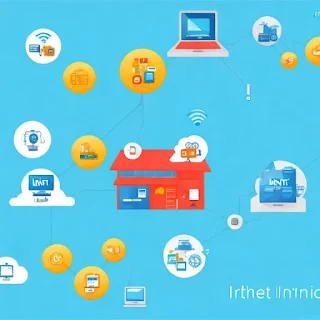 |
| Internet of Things (IoT) |
In today's interconnected world, the Internet of Things (IoT) is revolutionizing the way we live, work, and interact with technology. With its vast network of smart devices and sensors, IoT has the potential to transform industries, streamline processes, and enhance our daily lives. In this blog post, we will delve into the fascinating world of IoT, exploring its key concepts, applications, and the immense opportunities it presents for businesses and individuals alike.
Short Detail of Internet of Things (IoT).
Section 1: Understanding the Internet of Things (IoT).
In this section, we will provide a comprehensive overview of IoT, breaking down its core concepts in a reader-friendly manner. We will explain how IoT works, highlighting the network of connected devices, sensors, and data exchange that enables seamless communication and automation. By simplifying complex technical jargon, we aim to engage readers of all backgrounds and foster a better understanding of IoT.
Section 2: Real-World Applications of IoT.
This section will showcase the diverse range of applications where IoT is making a significant impact. From smart homes and cities to healthcare, agriculture, and industrial settings, we will explore how IoT is transforming various industries. Engaging examples and case studies will be used to illustrate the practicality and benefits of IoT implementations, such as energy efficiency, improved safety, enhanced productivity, and personalized experiences.
Section 3: Advantages and Challenges of IoT.
Here, we will delve into the advantages and challenges associated with the widespread adoption of IoT. We will discuss how IoT enables data-driven decision-making, predictive analytics, and automation, leading to increased operational efficiency and cost savings. Simultaneously, we will address concerns related to data security, privacy, and the need for robust cybersecurity measures to protect against potential vulnerabilities.
Section 4: The Future of IoT: Trends and Innovations.
In this forward-looking section, we will explore emerging
trends and innovations that are shaping the future of IoT. Topics such as edge
computing, artificial intelligence integration, 5G connectivity, and blockchain
applications will be discussed. By highlighting these advancements, we will
convey the immense potential for further growth and innovation within the IoT
landscape.
Complete Detail of Internet of Things (IoT).
Understanding the Internet of Things (IoT): A Comprehensive Guide.
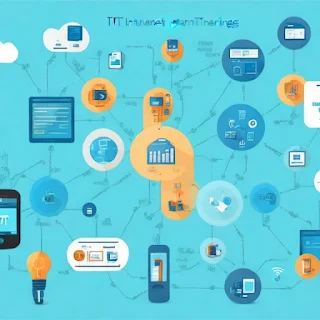 |
| Understanding the Internet of Things (IoT) |
Introduction:
In this comprehensive guide, we will dive deep into
understanding the Internet of Things (IoT) and its significance in our increasingly
interconnected world. From the basics to the intricacies, we will demystify IoT
and provide readers with a clear understanding of its key concepts and
functionalities.
Definition and Core Concepts of IoT:
We begin by defining IoT as a network of interconnected
physical devices, sensors, and software that communicate and exchange data with
each other through the internet. We explain the importance of connectivity,
data exchange, and the role of sensors in collecting real-time information.
How IoT Works:
In this section, we explore the underlying architecture and functioning of IoT. We break down the components, including devices, sensors, connectivity protocols, and cloud platforms. We explain how data is collected, transmitted, and analyzed, highlighting the role of gateways and IoT platforms in managing the massive influx of information.
Key Enablers of IoT:
We delve into the technologies that make IoT possible. This
includes wireless communication technologies like Wi-Fi, Bluetooth, and
cellular networks that facilitate device connectivity. We also discuss cloud
computing and edge computing, which provide the necessary infrastructure for
data storage, processing, and analysis.
Applications of IoT:
This section explores the vast array of applications where IoT is making a tangible impact. We highlight specific industries such as healthcare, agriculture, manufacturing, transportation, and smart cities, showcasing how IoT is revolutionizing processes, improving efficiency, and enabling data-driven decision-making.
Benefits of IoT Implementation:
Here, we outline the numerous advantages that organizations and individuals can gain from adopting IoT solutions. We emphasize how IoT improves operational efficiency, reduces costs, enhances productivity, and enables better resource management. We also touch upon the positive societal impacts of IoT, such as improved healthcare outcomes, increased sustainability, and safer environments.
Challenges and Considerations:
While IoT offers immense potential, it also comes with challenges that need to be addressed. We discuss security concerns, privacy issues, and the need for robust data protection measures. Additionally, we touch upon scalability, interoperability, and the potential for technological obsolescence as factors to consider when implementing IoT solutions.
Future Trends and Innovations:
In this forward-looking section, we explore the emerging trends and innovations that will shape the future of IoT. We discuss advancements such as artificial intelligence (AI) integration, blockchain technology, 5G connectivity, and edge computing. We highlight how these developments will further enhance the capabilities of IoT and open up new possibilities.
Real-World Applications of IoT: Transforming Industries and Enhancing Lives.
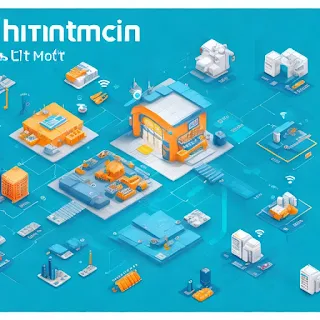 |
| Real-world Applications of the Internet of Things (IoT) |
Introduction:
In this article, we delve into the real-world applications of the Internet of Things (IoT) and explore how this transformative technology is revolutionizing various industries and improving the way we live. From smart homes to healthcare, manufacturing, and beyond, we showcase the practical and impactful implementations of IoT in today's world.
Smart Homes:
We start by highlighting how IoT is transforming our living spaces. Smart home devices, such as connected thermostats, lighting systems, security cameras, and voice assistants, enable homeowners to control and automate their homes remotely. We discuss how IoT enhances comfort, energy efficiency, security, and convenience, making our homes more intelligent and responsive.
Healthcare:
In this section, we delve into the significant impact of IoT on the healthcare industry. We explore how IoT-enabled wearable devices, remote patient monitoring systems, and connected medical equipment are revolutionizing healthcare delivery. We discuss the benefits of real-time health monitoring, early disease detection, and personalized patient care, emphasizing how IoT improves patient outcomes and reduces healthcare costs.
Industrial IoT (IIoT):
The industrial sector is experiencing a major transformation with the advent of IoT. We showcase how IIoT applications are optimizing manufacturing processes, supply chain management, and asset tracking. By collecting and analyzing data from sensors embedded in machinery, factories can achieve predictive maintenance, minimize downtime, optimize resource allocation, and enhance overall operational efficiency.
Agriculture:
IoT is revolutionizing the agricultural landscape, ushering in the era of precision farming. We explain how IoT-enabled sensors and drones provide real-time data on soil moisture, temperature, and crop health. Farmers can make data-driven decisions on irrigation, fertilizer application, and disease control, resulting in increased crop yields, reduced resource wastage, and improved sustainability.
Transportation and Logistics:
In this section, we explore the impact of IoT on transportation and logistics. We discuss how IoT-enabled tracking devices and telematics systems monitor vehicle performance, optimize routes, and improve fleet management. We highlight the benefits of real-time visibility, improved fuel efficiency, and enhanced supply chain efficiency, leading to cost savings and better customer service.
Smart Cities:
IoT plays a crucial role in building smart and sustainable cities. We showcase how IoT applications, such as intelligent traffic management systems, smart street lighting, waste management, and environmental monitoring, are transforming urban living. We discuss the benefits of reduced congestion, energy savings, improved safety, and enhanced quality of life for citizens.
Retail and Customer Experience:
IoT is reshaping the retail industry, enhancing customer experiences both online and offline. We explore how IoT-powered beacons, smart shelves, and personalized marketing solutions enable retailers to deliver targeted promotions, optimize inventory, and create seamless shopping experiences. We discuss the potential for personalized recommendations, streamlined checkout processes, and improved customer satisfaction.
Advantages and Challenges of IoT: Navigating the Opportunities and Considerations.
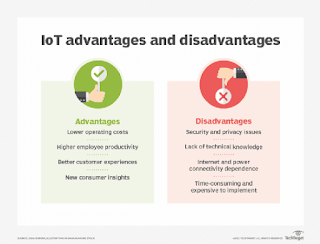 |
| Advantages and Disadvantages |
Introduction:
In this article, we delve into the advantages and challenges associated with the Internet of Things (IoT), shedding light on the benefits and considerations that organizations and individuals need to navigate. By understanding the advantages IoT brings and being aware of the challenges it presents, stakeholders can make informed decisions about adopting and implementing IoT solutions.
Advantages of IoT:
1.1 Improved Operational Efficiency:
We discuss how IoT enables organizations to optimize processes, automate tasks, and improve operational efficiency. Real-time data collection, analysis, and automation result in streamlined operations, reduced errors, and increased productivity.
1.2 Cost Savings:
We highlight how IoT implementations can lead to cost savings. Examples include predictive maintenance, where IoT sensors can detect and address equipment issues before they escalate, and energy management systems that optimize resource usage, resulting in reduced operational costs.
1.3 Enhanced Customer Experience:
IoT empowers businesses to deliver personalized and seamless customer experiences. Through IoT-enabled devices, organizations can gather valuable insights, provide personalized recommendations, and offer convenient, connected services to their customers.
1.4 Data-Driven Decision-Making:
We emphasize how IoT generates vast amounts of data that can be analyzed to gain valuable insights. Data-driven decision-making enables organizations to make informed choices, identify trends, and uncover opportunities for growth and optimization.
Challenges and Considerations of IoT:
2.1 Security and Privacy:
We discuss the inherent security risks in IoT systems, such as unauthorized access, data breaches, and potential privacy violations. Highlighting the need for robust security measures and encryption protocols, we emphasize the importance of protecting sensitive data and maintaining user privacy.
2.2 Interoperability and Standards:
We address the challenge of ensuring interoperability among various IoT devices and platforms. The lack of uniform standards and protocols can hinder seamless communication and data exchange between different devices, potentially limiting the scalability and effectiveness of IoT solutions.
2.3 Scalability and Infrastructure:
IoT implementations require scalable infrastructure to accommodate the increasing number of connected devices and the vast amount of data generated. We explore the challenges of scaling IoT systems and the need for robust networks, data storage, and processing capabilities.
2.4 Complexity and Technical Expertise:
Implementing IoT solutions can be complex, requiring expertise in areas such as hardware, software, networking, and data analytics. We discuss the challenge of acquiring and retaining skilled professionals who can design, deploy, and manage IoT systems effectively.
The Future of IoT: Exploring Emerging Trends and Innovations.
 |
| Trends and Innovations |
Introduction:
In this article, we explore the exciting future of the Internet of Things (IoT) and the trends and innovations that will shape its trajectory. From cutting-edge technologies to evolving industry applications, we provide insights into the advancements that will further propel IoT into the future.
Edge Computing:
We discuss how edge computing is revolutionizing IoT by enabling data processing and analysis at the network's edge, closer to the source of data generation. This trend reduces latency, enhances real-time decision-making capabilities, and minimizes reliance on cloud infrastructure.
Artificial Intelligence (AI) Integration:
We explore the integration of AI algorithms and machine learning techniques with IoT systems. By combining AI with IoT-generated data, organizations can unlock powerful insights, improve predictive capabilities, automate processes, and enhance overall system intelligence.
5G Connectivity:
We highlight the transformative impact of 5G connectivity on
IoT. With its high bandwidth, low latency, and ability to connect a massive
number of devices, 5G will enable faster and more reliable communication,
facilitating the proliferation of IoT devices and applications.
Blockchain and IoT:
We discuss how blockchain technology can enhance security,
privacy, and trust in IoT systems. By providing a decentralized and
tamper-resistant ledger, blockchain can ensure secure data exchange, verify
device identities, and enable transparent and auditable transactions in IoT
ecosystems.
Smart Cities and Infrastructure:
We explore how IoT is set to revolutionize urban environments and infrastructure. Smart city initiatives, powered by IoT technologies, will enhance energy management, optimize transportation, improve public safety, and enable efficient resource allocation to create sustainable and livable cities.
Industrial IoT (IIoT) Advancements:
We delve into the advancements in Industrial IoT, where IoT
applications are transforming industrial processes, supply chains, and asset
management. Innovations such as digital twins, predictive maintenance, and
AI-powered analytics will drive increased productivity, cost savings, and
operational efficiency in industrial settings.
Wearable Technology and Healthcare:
We discuss the future of wearable devices and their
integration with healthcare systems. IoT-enabled wearable’s will continue to
advance remote patient monitoring, personalized healthcare delivery, and early
disease detection, empowering individuals to take control of their health and
well-being.
Environmental Monitoring and Sustainability:
We emphasize the growing importance of IoT in environmental
monitoring and sustainability efforts. IoT sensors and devices can collect
real-time data on air quality, water management, waste management, and energy
consumption, enabling informed decision-making and promoting sustainable
practices.
Conclusion:
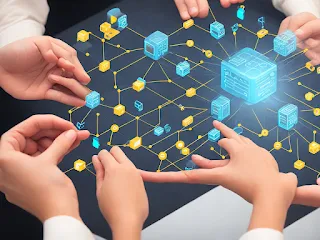 |
| IoT's Transformative Power |
As we conclude our journey into the world of IoT, it becomes clear that we are standing at the precipice of a connected revolution. IoT's transformative power is already making a significant impact across industries and will continue to shape the way we live and interact with technology. From improving efficiency and productivity to enhancing our daily lives and addressing global challenges, IoT presents a myriad of opportunities. Embracing IoT and its potential can empower businesses and individuals to thrive in an increasingly connected world.

.jpeg)

